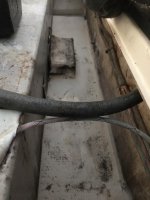Double checked stuff today as I worked on cleaning off all the previous sealant. The only place I saw any wet/rotting core was a few spots around the edges of the side steps. It appeared there was some sort of protection around those edges, but it had come off in some spots, and that's where the core was wet. I dug that out, put some expanding foam in to fill in the larger areas, then used epoxy or fiberglass to finish out the fill. Regarding my fuel sender, I was having my fuel gauge read empty, when there was still 30 gals of fuel in the tank. When I pulled the old sender, it appeared that the problem was likely due to the length of the sender arm. It appeared a bit to short and would hit it's full stroke with about 30 gals still in the tank. I set up the new sender to be a little more accurate. Hope I got it right when I go to fill the tank back up in the spring. Also pulled the fuel pickup tube to check that. In the process of cleaning the fitting up, broke off the fuel line barbed fitting. That barbed fitting was an anti-siphon type. Seems like that adds a bit of restriction to the fuel pick up. Probably why the little electric auxiliary pump I have can't pull fuel out except at a trickle. The main and kicker seem to be able to pull enough fuel with out problem, but I wonder if the anti-siphon fitting is necessary. (I did replace it with another anti-siphon fitting.) Also, the bottom of the pickup tube had some wire screen on it. The new tube I purchased did not, and I elected not to try and install that screen on the new tube with the possibility it could come off in the tank. Still have a little more cleaning to do where the sealant will be applied, and tomorrow is only suppose to be 32 before warming up again this weekend. So I'll wait until this weekend to reinstall the floor. Maybe I was just lucky, but it really didn't seem like that hard of a job to do this. Hardest part was probably reaching inside the access plates on the side steps to remove the screws holding the side steps on. I didn't notice any hold downs on the fuel tank, and in fact I can move it around slightly. (It's empty right now.) I'm thinking it must just be it's weight and snug fit within the space that keeps it in place. Lastly, like a few others here, I built a bilge sucker system to suck out the little bit of remaining water that the bilge pump doesn't pull. After pulling the sponges out to see they were half or more dissolved, and then having some of that mess plug up the bilge drain hole, I decided to pull that system out rather than finish permanently installing it. I suspect there will always be some water in the bilge anyway, especially in the side chines, and the best way to dry that up, since it's on the trailer when I'm not on the water, is to keep the bow raised and drain plug out, and even leave the transom compartments open. I think most the bilge water, when sitting level, is going to be under the cockpit floor area anyway, and without routine access to maintain any bilge suckers in that area, it's not a maintainable system. JMHO. Colby

